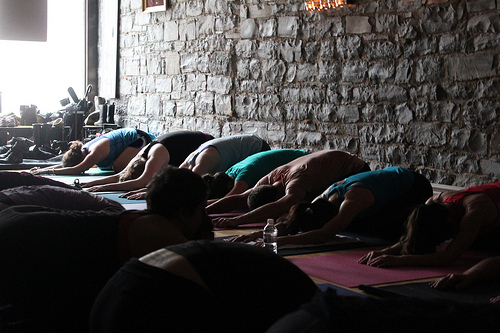*Disclaimer: Elephant Journal articles represent the personal views of the authors, and can not possibly reflect Elephant Journal as a whole. Disagree with an Op-Ed or opinion? We’re happy to share your experience here. This website is not designed to, and should not be construed to, provide medical advice, professional diagnosis, opinion or treatment to you or any other individual, and is not intended as a substitute for medical or professional care and treatment.
~
I live with type 1 diabetes.
Flowers are pretty, girls are pretty, watching the sunset is pretty. But diabetes—not so much!
Picture this: It’s one in the morning and I’ve woken for the third time and checked my blood sugar, only to find that it’s low.
I take a nightly injection of insulin at nine p.m., and normally that shot will keep my blood sugar at a steady number until five a.m. However, I have LADA type 1 diabetes—Latent Autoimmune Diabetes in Adults—and sometimes my pancreas decides it’s not a useless organ sitting just underneath my ribcage. Instead, it’s a frisky puppy obsessed with a ball and it’s squirting insulin all over the place.
As I haul myself out of bed, don my slippers, and grab my computer, I prepare myself for the long night ahead, food all over the counter, fridge wide open, and way too much Instagram.
It’s during my midnight forays to treat a low blood sugar that I have to stop and remind myself that I haven’t always lived like this. I had a life before type 1 rocked my world.
I was diagnosed nine years ago, almost 25 years into my life. As a yogi and yoga teacher, I was convinced that my practice made me invincible. I was dedicated, passionate, and devoted to my health.
The day I was diagnosed was the worst day ever. It started with a visit to my local doctor after a series of random blood tests. He just burst out with the news before I’d even sat down.
“You have diabetes—and it’s not a good prognosis!”
My whole world tanked in that moment. I could see his mouth moving, I could hear him explaining that this was something I’d have to figure out how to manage, but all I could hear was my heart going—badoom, badoom.
“This is not happening,” I told myself, “I feel fine, yogis don’t get diabetes!”
But they do. Type 1 diabetes doesn’t discriminate.
It is an autoimmune condition where the body attacks its own beta-producing insulin cells. The body uses insulin to regulate the amount of sugar we have in our blood. Our brain needs glucose to power our nervous system. If we have too much glucose or too little glucose, we basically damage the organs and tissues and nerves in the body. That’s why people who live with any type of diabetes deal with kidney disease, heart attack, stroke, blindness, and circulation problems that lead to amputation.
When I tell people that I live with diabetes they insist it can’t be true. “You’re too thin, you do yoga and besides isn’t that a lifestyle disease?”
Educating people on the difference between type one and two can be daunting. As soon as I talk about islet cells, auto-antibodies, and carb counting people’s eyes roll back in their heads. No one ever really knows what to say especially when you add that,” It’s not just something that happens to kids. It can strike at any age and there’s no known cause or cure.”
Sadly, even people like me—who dedicate their whole life to yoga—can be diagnosed with it.
Adjusting to my life after diagnosis wasn’t easy. At first, I felt ashamed, gutted, and as though yoga had completely failed me. I can remember wanting to quit and thinking, “all those years of sun salutations, for what?”
Thankfully I’m not a quitter! I just had to wrap my mind around my new reality. “You got this,” I kept telling myself as I changed my diet and amped up my yoga regime, “there’s no way diabetes is going to rain on your parade!”
It took time for me to accept that yoga wasn’t the only solution, and that an allopathic medicine like insulin was the way forward. It also took time for me to forgive myself for thinking that the yoga practices were the perfect cure.
Over time I began to understand that yoga, rather than failing me, had actually saved me. Especially after my diagnosis.
When I couldn’t cope with rollercoaster emotions, I dove onto the mat. When I felt like the fear of unknown complications would choke me, I practiced healing pranayama. When my nervous system was fried from treating hypos (hypoglycemic episodes,) I practiced calming yoga nidras and soothing meditations. When I felt like my heart would break, I chanted mantras. And when I found myself getting lost in depressive thoughts and anxious projections, the depth of the yogic teachings reminded me that I am not my thoughts, my body, or even this disease.
Yoga works.
It reminds me that I am stronger than I think. When I feel my energy waning I use a posture like handstand to reboot my system. As soon as I flip upside down I’m full of energy and ready for more.
Yoga keeps me on an even keel. It’s hard, when I see numbers crashing or soaring on my blood sugar meter, not to get tunnel vision. Yoga reminds me that what happens on one side must happen on the other. Life is a balancing act and I’m in charge.
Yoga gives me courage! When all my fears and insecurities pile up, I deep dive into challenging poses and force myself to let go.
Yoga softens me in the hardest moments. When I feel isolated or like I have to tough it out, the practice gives me permission to let the tears fall.
Amidst all the very practical benefits of better sleep, digestion, increased sensitivity to insulin, and stable weight—I have come to understand the deeper meaning of yoga.
Even disease and chronic conditions are inseparably part of the whole. The body may malfunction, parts may wear out, the body may eventually die, but the totality of creation continues.
Yoga describes the nature of the human being as whole and complete.
Embracing this, knowing this, has been my lifeline and my cure.
~
Author: Rachel Zinman
Image: fashionbyhe/flickr
Editor: Lieselle Davidson

 Share on bsky
Share on bsky







Read 12 comments and reply